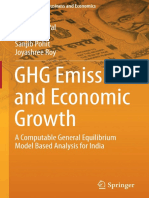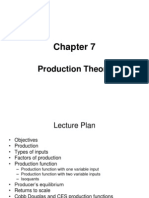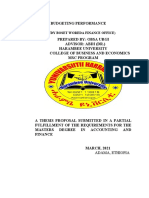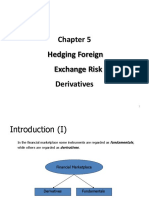100%(1)100% found this document useful (1 vote)
117 viewsPresentation On Balance of Payment (BOP)
Presentation On Balance of Payment (BOP)
Uploaded by
Abdii DhufeeraThe balance of payments (BOP) records a country's transactions with the rest of the world. It has three components: the current account which covers trade in goods and services and income flows; the capital account which covers investment-related flows; and financial flows which are recorded in the financial account. A BOP surplus occurs when more foreign currency flows into a country than flows out, putting upward pressure on the currency, while a deficit represents excess outflows.
Copyright:
© All Rights Reserved
Available Formats
Download as PPT, PDF, TXT or read online from Scribd
Presentation On Balance of Payment (BOP)
Presentation On Balance of Payment (BOP)
Uploaded by
Abdii Dhufeera100%(1)100% found this document useful (1 vote)
117 views17 pagesThe balance of payments (BOP) records a country's transactions with the rest of the world. It has three components: the current account which covers trade in goods and services and income flows; the capital account which covers investment-related flows; and financial flows which are recorded in the financial account. A BOP surplus occurs when more foreign currency flows into a country than flows out, putting upward pressure on the currency, while a deficit represents excess outflows.
Original Description:
Balance of Payment
Original Title
Balance of Payment Final
Copyright
© © All Rights Reserved
Available Formats
PPT, PDF, TXT or read online from Scribd
Share this document
Did you find this document useful?
Is this content inappropriate?
The balance of payments (BOP) records a country's transactions with the rest of the world. It has three components: the current account which covers trade in goods and services and income flows; the capital account which covers investment-related flows; and financial flows which are recorded in the financial account. A BOP surplus occurs when more foreign currency flows into a country than flows out, putting upward pressure on the currency, while a deficit represents excess outflows.
Copyright:
© All Rights Reserved
Available Formats
Download as PPT, PDF, TXT or read online from Scribd
Download as ppt, pdf, or txt
100%(1)100% found this document useful (1 vote)
117 views17 pagesPresentation On Balance of Payment (BOP)
Presentation On Balance of Payment (BOP)
Uploaded by
Abdii DhufeeraThe balance of payments (BOP) records a country's transactions with the rest of the world. It has three components: the current account which covers trade in goods and services and income flows; the capital account which covers investment-related flows; and financial flows which are recorded in the financial account. A BOP surplus occurs when more foreign currency flows into a country than flows out, putting upward pressure on the currency, while a deficit represents excess outflows.
Copyright:
© All Rights Reserved
Available Formats
Download as PPT, PDF, TXT or read online from Scribd
Download as ppt, pdf, or txt
You are on page 1of 17
BALANCE OF PAYMENT
Presentation on Balance Of Payment
(BOP)
Cont…
• Balance of payments (BOP) accounts are an accounting record of
all monetary transactions between a country and the rest of the
world. These transactions include payments for the country's
exports and imports of goods & services, financial capital, and
financial transfers.
• A country has to deal with other countries in respect of 3 items:
• Visible items which include all types of physical goods exported
and imported.
• Invisible items which include all those services whose export and
import are not visible. e.g. transport services, medical services etc.
• Capital transfers which are concerned with capital receipts and
capital payment.
Cont….
.Definition-
According to Kindle Berger, "The balance of
payments of a country is a systematic record of all
economic transactions between the residents of the
reporting country and residents of foreign countries
during a given period of time".
4. Features
•It is a systematic record of all economic transactions
between one country and the rest of the world.
• It includes all transactions, visible as well as
invisible.
•It relates to a period of time. Generally, it is an
annual statement.
•It adopts a double-entry book-keeping system. It has
two sides: credit side and debit side. Receipts are
recorded on the credit side and payments on the debit
side.
Double-entry Accounting in the BOP
• All transactions are either debit or credit
transactions
• Credit transactions result in receipt of
payment from foreigners
– Merchandise exports (valued f.o.b.)
– Transportation and travel receipts
– Income received from investments abroad
– Gifts received from foreign residents
– Aid received from foreign governments
Double-entry Accounting (Cont’d)
• Debit transactions involve to payments to foreigners
– Merchandise imports
– Transportation and travel expenditures
– Income paid on investments of foreigners
– Gifts to foreign residents
– Aid given by home government
– Overseas investments by home country residents
• Each credit transaction has a balancing debit
transaction, and vice versa, so the overall balance of
payments is always in balance.
5. Components of BOP
1. Current Account Balance :- BOP on current account
is a statement of actual receipts and payments in
short period. It includes the value of export and
imports of both visible and invisible goods.
• There can be either surplus or deficit in current
account.
• The current account includes:- export & import
of services, interests, profits, dividends and
unilateral receipts/payments from/to abroad.
Current Account
• The current account is that balance of
payments account in which all short-term
flows of payments are listed:
– Goods and services balance (exports – imports)
• Merchandise trade balance (exports – imports)
• Services balance (exports – imports)
What are Services?
• Travel and tourism
• Trade transportation
• Insurance
• Education
• Financial, technical, and marketing services
• Telecommunication
• Use of property rights (royalties)
• Other professional and consulting services
2. Capital Account Balance
It is difference between the receipts and
payments on account of capital account. It refers
to all financial transactions.
The capital account involves inflows and outflows
relating to investments, short term
borrowings/lending, and medium term to long
term borrowing/lending.
There can be surplus or deficit in capital account.
It includes: - private foreign loan flow, movement
in banking capital, official capital transactions,
reserves, gold movement etc.
Capital Account
• The capital and financial account is that balance of
payments account in which all cross-border
transactions involving financial assets are listed.
This includes transactions between foreign and
domestic residents, and foreign and domestic
governments.
– All purchases or sales of assets, including:
• Direct investment
• Securities (debt)
• Bank claims and liabilities
• Official reserves transactions
• When U.S. citizens buy foreign securities or when foreigners
buy U.S. securities, they are listed here as outflows and inflows,
respectively.
Foreign Direct Investment (FDI)
• Any flow of lending to, or purchases of ownership in, a
foreign enterprise that is largely owned by residents of the
investing country.
– Securities (stocks and bonds)
– Loans
– Bank deposits
– Minority ownership positions
• FDI is the purchase of assets to establish financial control of a
foreign entity. Generally ownership of 10% or more of a
company’s outstanding stock is considered FDI.
• Portfolio investment involves little management control or
interest, and is solely for financial gain.
Official Reserve Assets
• Early on in this century, this was primarily gold
• Now primarily financial assets denominated in
a foreign currency that is widely accepted in
international transactions:
– Euro assets (heavily used by U.S.)
– Yen assets (heavily used by U.S.)
– U.S. dollar assets (key currency worldwide)
– Reserve positions in IMF
– SDRs (created by IMF)
Overall BOP -:
• Total of a country’s current and capital account is
reflected in overall Balance of payments.
• It includes errors and omissions and official reserve
transactions.
• The errors may be due to statistical discrepancies &
omission may be due to certain transactions may
not be recorded.
• For e.g.: A remittance by an Ethiopian working
abroad to Ethiopian may not yet recorded,
• The errors and omissions amount equals to the
amount necessary to balance both the sides
Statistical Discrepancy?
• It is the net result of errors and omissions on
both the credit and debit sides.
• Where do these errors come from?
– Under-reporting merchandise imports
– Under-reporting investment incomes
– Under-reporting capital exports
– Basically, people succeed in hiding their imports,
foreign investment incomes, capital flight from
their governments for tax and other purposes.
BOP Surplus and Deficit (Continued)
• In terms of the supply and demand of a
nation’s currency, there is:
– A balance of payments surplus if quantity
demanded for a currency exceeds quantity
supplied, putting upward pressure on the value
of the nation’s currency.
– A balance of payments deficit if quantity
supplied of a currency exceeds quantity
demanded, putting downward pressure on the
value of the nation’s currency.
Causes of Disequilibrium
Includes
• Natural causes – e.g. floods, earthquake etc.
• Economic causes – e.g. Cyclical Fluctuations,
Inflation, Demonstration Effect etc.
• Political causes – e.g. international relation,
political instability, etc.
• Social factors – e.g. change in taste and
preferences etc. 1.
You might also like
- helloBSBHRM614 Hel Lpassessment Task 3 2021 (4599) (1qqqqq) 2Document9 pageshelloBSBHRM614 Hel Lpassessment Task 3 2021 (4599) (1qqqqq) 2Pradip RawalNo ratings yet
- Arun Sharma CAT (DI and LR) PDFDocument18 pagesArun Sharma CAT (DI and LR) PDFRupasinghNo ratings yet
- FM FS For GlobeDocument5 pagesFM FS For GlobeIngrid garingNo ratings yet
- Chapter Two Investment Allowances NotesDocument12 pagesChapter Two Investment Allowances NotesTriila manillaNo ratings yet
- Export Selling vs. Export MarketingDocument22 pagesExport Selling vs. Export MarketingaudityaerosNo ratings yet
- NFP AssDocument9 pagesNFP AssAbdii Dhufeera100% (2)
- Barun Deb Pal, Vijay P. Ojha, Sanjib Pohit, Joyashree Roy Auth. GHG Emissions and Economic Growth A Computable General Equilibrium Model Based Analysis For IndiaDocument199 pagesBarun Deb Pal, Vijay P. Ojha, Sanjib Pohit, Joyashree Roy Auth. GHG Emissions and Economic Growth A Computable General Equilibrium Model Based Analysis For IndiaFernando de AssisNo ratings yet
- Foreign Exchange & Its ParticipantsDocument2 pagesForeign Exchange & Its ParticipantsSK Lashari100% (1)
- Balance of PaymentDocument38 pagesBalance of PaymentAyush SinghNo ratings yet
- FTP Icai MaterialDocument61 pagesFTP Icai MaterialsubbuNo ratings yet
- E-Way BillDocument8 pagesE-Way BillJanhvi BhardwajNo ratings yet
- Balance of Payment: Meaning and ComponentsDocument6 pagesBalance of Payment: Meaning and ComponentsForum DaghaNo ratings yet
- Procedures To Obtain Export FinanceDocument3 pagesProcedures To Obtain Export FinanceVajju ThoutiNo ratings yet
- Export FinancingDocument27 pagesExport FinancingPresha ShethNo ratings yet
- Production Theory and EstimationDocument26 pagesProduction Theory and EstimationAqib ArshadNo ratings yet
- Balance of PaymentsDocument25 pagesBalance of PaymentsViolaNo ratings yet
- Investment BankingDocument64 pagesInvestment BankingSandeep YadavNo ratings yet
- Unit 3: The Role of Public Policies in Governing BusinessDocument41 pagesUnit 3: The Role of Public Policies in Governing BusinessAnonymous 5RO7Xov3A4No ratings yet
- Cost Concepts in EconomicsDocument15 pagesCost Concepts in EconomicsHarsha mattaNo ratings yet
- CH 3 Institutional Support To International BusinessDocument77 pagesCH 3 Institutional Support To International Businessgouthamireddy75No ratings yet
- Exchange Rate RegimesDocument17 pagesExchange Rate Regimesnimmy celin mariya100% (1)
- Uniform CostDocument5 pagesUniform CostJASMINE REGI100% (2)
- Money Market's InstrumentsDocument20 pagesMoney Market's InstrumentsManmohan Prasad RauniyarNo ratings yet
- Core Risks in BankingDocument9 pagesCore Risks in BankingVenkatsubramanian R Iyer100% (1)
- Balance of PaymentsDocument34 pagesBalance of PaymentsRavi Sista100% (1)
- Source DocumentsDocument3 pagesSource Documentsziad12321No ratings yet
- International Financial MarketsDocument42 pagesInternational Financial Marketschitu1992No ratings yet
- Inflation AccountingDocument10 pagesInflation AccountingKunal ModiNo ratings yet
- Business EthicsDocument10 pagesBusiness EthicsGlen Mark FortunNo ratings yet
- Banking Allied ServicesDocument30 pagesBanking Allied ServicesSrinivasula Reddy P50% (2)
- National IncomeDocument30 pagesNational IncomeTaruna Dureja BangaNo ratings yet
- International Marketing Intelligence 2Document4 pagesInternational Marketing Intelligence 2Prathamesh PrabhutendolkarNo ratings yet
- Pre-Shipment-Post-Shipment 14519Document24 pagesPre-Shipment-Post-Shipment 14519aeeeNo ratings yet
- Assessment of Various EntitiesDocument31 pagesAssessment of Various Entitiesinsathi0% (1)
- 16 Chapter 14-Foreign Finance, Investment, and Aid, Controversies and OpportunitiesDocument55 pages16 Chapter 14-Foreign Finance, Investment, and Aid, Controversies and OpportunitiesriverajohniversonNo ratings yet
- The Money and Capital MarketsDocument50 pagesThe Money and Capital MarketsclaytongarryNo ratings yet
- Accounting For Consigned GoodsDocument6 pagesAccounting For Consigned GoodsHumphrey OdchigueNo ratings yet
- Inflation TargetingDocument16 pagesInflation TargetingKathryn PuyatNo ratings yet
- Ib Economics Section 3.3 The Balance of PaymentsDocument82 pagesIb Economics Section 3.3 The Balance of PaymentsTita RachmawatiNo ratings yet
- Banking Finanacial Services Management Unit I: Two Mark QuestionsDocument21 pagesBanking Finanacial Services Management Unit I: Two Mark QuestionsIndhuja MNo ratings yet
- Foreign Exchange Rate QuotationsDocument6 pagesForeign Exchange Rate Quotationsalu_tNo ratings yet
- Journal Ledger Trial BalanceDocument22 pagesJournal Ledger Trial BalanceWilliam C JacobNo ratings yet
- Bop & International Economics LinkagesDocument77 pagesBop & International Economics LinkagesGaurav Kumar100% (2)
- Overview of Indian Financial Systems and MarketsDocument17 pagesOverview of Indian Financial Systems and MarketsPremendra SahuNo ratings yet
- Rural ConsumerDocument22 pagesRural ConsumerAbhinav Jayabalan100% (1)
- Forex Operations: Prof S P GargDocument25 pagesForex Operations: Prof S P GargProf S P Garg100% (2)
- 4 International Taxation Lecture Note PPP 2010 2nd Sem MTDocument29 pages4 International Taxation Lecture Note PPP 2010 2nd Sem MTDawit DawitNo ratings yet
- Legal Issues in International MarketingDocument11 pagesLegal Issues in International MarketinggazmeerNo ratings yet
- ProductionDocument26 pagesProductionHarsh Dehariya100% (1)
- Balance of Payment AdjustmentDocument37 pagesBalance of Payment AdjustmentJash ShethiaNo ratings yet
- PROMISSORY NOTE-agreement BlankDocument2 pagesPROMISSORY NOTE-agreement BlankOlive FaustinoNo ratings yet
- Chapter 16 - Exporting, Importing, and CountertradeDocument32 pagesChapter 16 - Exporting, Importing, and CountertradeKaye Jenny ParedesNo ratings yet
- Provisions Relating To Default in Furnishing Returns Under GSTDocument2 pagesProvisions Relating To Default in Furnishing Returns Under GSTsakshiNo ratings yet
- International Trade EnvironmentDocument17 pagesInternational Trade Environmentankitkmr25No ratings yet
- Balance of Payments: Presented by Mamta KatariaDocument26 pagesBalance of Payments: Presented by Mamta KatariaDipti YengulNo ratings yet
- Foreign Exchange RateDocument3 pagesForeign Exchange RatesamchannuNo ratings yet
- Portfolio TheoryDocument78 pagesPortfolio TheoryAmit PrakashNo ratings yet
- Regulatory Framework of Merchant Banks in IndiaDocument1 pageRegulatory Framework of Merchant Banks in IndiaParul PrasadNo ratings yet
- Ratio Analysis Notes (Theory)Document3 pagesRatio Analysis Notes (Theory)Karishma KatiyarNo ratings yet
- Cash Management ServicesDocument5 pagesCash Management ServicesMadhur AnandNo ratings yet
- Submitted By: Foreign Exchange Business of Sonali BankDocument76 pagesSubmitted By: Foreign Exchange Business of Sonali BankHimadri HimuNo ratings yet
- Demand Forecasting Methods PPT MBADocument20 pagesDemand Forecasting Methods PPT MBAkeshmuNo ratings yet
- Balance of Payments-2Document36 pagesBalance of Payments-2AlexNo ratings yet
- Balance of Payment COR ENVDocument12 pagesBalance of Payment COR ENVPranjit KalitaNo ratings yet
- Terms of Trade: Balance of Payment Disequilibrium Corrective MeasuresDocument34 pagesTerms of Trade: Balance of Payment Disequilibrium Corrective MeasuresvijiNo ratings yet
- The Effect of Working Capital Management On The Manufacturing Firms' ProfitabilityDocument20 pagesThe Effect of Working Capital Management On The Manufacturing Firms' ProfitabilityAbdii DhufeeraNo ratings yet
- Effects of Corporate Governance Practices On Financial Performance of Manufacturing Share Companies in AdamaDocument22 pagesEffects of Corporate Governance Practices On Financial Performance of Manufacturing Share Companies in AdamaAbdii DhufeeraNo ratings yet
- Assessment of Credit Management Practice of Dashen Bank S.C in Ethiopia (In The Case of Adama District)Document25 pagesAssessment of Credit Management Practice of Dashen Bank S.C in Ethiopia (In The Case of Adama District)Abdii Dhufeera50% (2)
- Factors Influencing The Adoption of Mobile Banking Service"Document42 pagesFactors Influencing The Adoption of Mobile Banking Service"Abdii Dhufeera100% (1)
- Credit Risk Management On Ethiopian Commercial Banks": Case of Selected Commercial Banks in Adama TownDocument36 pagesCredit Risk Management On Ethiopian Commercial Banks": Case of Selected Commercial Banks in Adama TownAbdii Dhufeera100% (2)
- (Case Study Boset Woreda Finance Office) : Adama, EthiopiaDocument28 pages(Case Study Boset Woreda Finance Office) : Adama, EthiopiaAbdii DhufeeraNo ratings yet
- Assessment of Credit Management Practice of Dashen Bank S.C in Ethiopia (In The Case of Adama District)Document25 pagesAssessment of Credit Management Practice of Dashen Bank S.C in Ethiopia (In The Case of Adama District)Abdii Dhufeera50% (2)
- Jiksa Ayana Proposal 2Document35 pagesJiksa Ayana Proposal 2Abdii DhufeeraNo ratings yet
- Jiksa 1Document34 pagesJiksa 1Abdii DhufeeraNo ratings yet
- Performance Analysis of Microfinance Institution and Its Sustainability and Outreach (Case Study in Huruta Town, Oromia, Ethiopia)Document19 pagesPerformance Analysis of Microfinance Institution and Its Sustainability and Outreach (Case Study in Huruta Town, Oromia, Ethiopia)Abdii DhufeeraNo ratings yet
- Performance Analysis of Microfinance Institution and Its Sustainability and Outreach (Case Study in Huruta Town, Oromia, Ethiopia)Document23 pagesPerformance Analysis of Microfinance Institution and Its Sustainability and Outreach (Case Study in Huruta Town, Oromia, Ethiopia)Abdii DhufeeraNo ratings yet
- Table of ContentsDocument1 pageTable of ContentsAbdii DhufeeraNo ratings yet
- Unit 3Document34 pagesUnit 3Abdii DhufeeraNo ratings yet
- Tax Assessment and Collection Challenges in Lode Hetosa District: Arsi, Oromia, Ethiopia Evidence From Category "B'' Tax-PayersDocument22 pagesTax Assessment and Collection Challenges in Lode Hetosa District: Arsi, Oromia, Ethiopia Evidence From Category "B'' Tax-PayersAbdii Dhufeera100% (3)
- Herambe University Faculty of Business and Economics Department of Mba - ProgramDocument34 pagesHerambe University Faculty of Business and Economics Department of Mba - ProgramAbdii Dhufeera100% (3)
- Unit 2Document34 pagesUnit 2Abdii DhufeeraNo ratings yet
- Unit 1Document29 pagesUnit 1Abdii DhufeeraNo ratings yet
- Worksheet For Cost Accounting11Document3 pagesWorksheet For Cost Accounting11Abdii Dhufeera100% (1)
- Unit 4Document27 pagesUnit 4Abdii DhufeeraNo ratings yet
- Analysis of The Contributionof Vat For Economic Development and Social Spending in EthiopiaDocument108 pagesAnalysis of The Contributionof Vat For Economic Development and Social Spending in EthiopiaAbdii DhufeeraNo ratings yet
- Table of ContentsDocument1 pageTable of ContentsAbdii DhufeeraNo ratings yet
- CH 4 Hedging and DerivativesDocument31 pagesCH 4 Hedging and DerivativesAbdii DhufeeraNo ratings yet
- Analysis of The Contributionof Vat For Economic Development and Social Spending in EthiopiaDocument108 pagesAnalysis of The Contributionof Vat For Economic Development and Social Spending in EthiopiaAbdii DhufeeraNo ratings yet
- Bond ValuationDocument38 pagesBond ValuationAbdii DhufeeraNo ratings yet
- Chapter 3 B Accounting For Governmental Operating Activities-Illustrative Transactions and Financial StatementsDocument33 pagesChapter 3 B Accounting For Governmental Operating Activities-Illustrative Transactions and Financial StatementsAbdii DhufeeraNo ratings yet
- AIS Ch6Document48 pagesAIS Ch6Abdii DhufeeraNo ratings yet
- Chera Emiru/AIS/2005/ s1 1Document49 pagesChera Emiru/AIS/2005/ s1 1Abdii DhufeeraNo ratings yet
- OGP 2025 Timetables B1 2025Document27 pagesOGP 2025 Timetables B1 2025Vikas KapoorNo ratings yet
- Chapter 3. Section 3.2Document31 pagesChapter 3. Section 3.2Hadeel Al-OtaibiNo ratings yet
- Additional Solved Problems and MinicasesDocument154 pagesAdditional Solved Problems and Minicasesashok100% (1)
- PaybackDocument3 pagesPaybackMd. Masudur Rahman MasumNo ratings yet
- India'S Credit Ecosystem: A Review ofDocument27 pagesIndia'S Credit Ecosystem: A Review ofMohit BoralkarNo ratings yet
- Unit 4 - Learning Journal (BUS - 1101)Document2 pagesUnit 4 - Learning Journal (BUS - 1101)Hnin Chal Aung KoNo ratings yet
- Mitsubishi Corporation, Tokyo Head OfficeDocument1 pageMitsubishi Corporation, Tokyo Head OfficeeltonNo ratings yet
- DBC011 Business Economics EMDocument338 pagesDBC011 Business Economics EMsandiNo ratings yet
- Equity Valuation Case StudyDocument112 pagesEquity Valuation Case StudyKarl MarxNo ratings yet
- Stanford Executive Program: Sample Course DescriptionsDocument6 pagesStanford Executive Program: Sample Course DescriptionsAndy MengNo ratings yet
- Business Plan Hair SalonDocument52 pagesBusiness Plan Hair SalonFazira Diana83% (6)
- Mumbai TicketDocument1 pageMumbai Ticketkapil chavanNo ratings yet
- Sole Proprietor WaiverDocument2 pagesSole Proprietor WaiverSarah Heiselman TomlinsonNo ratings yet
- JP Morgan FDI PDFDocument6 pagesJP Morgan FDI PDFMohit S MehtaNo ratings yet
- Week1 AnswersDocument7 pagesWeek1 AnswersyzaNo ratings yet
- Logistics Purchasing PDFDocument29 pagesLogistics Purchasing PDFMary G. EbcasNo ratings yet
- Home Insurance Policy: DeclarationsDocument2 pagesHome Insurance Policy: DeclarationsPekunNo ratings yet
- Merchandising BusinessDocument64 pagesMerchandising BusinessKim Pacer100% (1)
- Chronology of Important Events in The History of The Reserve BankDocument4 pagesChronology of Important Events in The History of The Reserve BankBishwajitSinhaNo ratings yet
- AfPS&CS Ch-01Document10 pagesAfPS&CS Ch-01Amelwork AlchoNo ratings yet
- Amcat1234 PDFDocument3 pagesAmcat1234 PDFPazhani Vignesh100% (2)
- Chapter 22 - Futures MarketsDocument9 pagesChapter 22 - Futures MarketsminibodNo ratings yet
- TVS Motor Co LTD (TVSL IN) - StandardizedDocument34 pagesTVS Motor Co LTD (TVSL IN) - StandardizedAswini Kumar BhuyanNo ratings yet
- Principal Islamic Lifetime Sukuk Fund (Formerly Known As CIMB Islamic Sukuk Fund)Document2 pagesPrincipal Islamic Lifetime Sukuk Fund (Formerly Known As CIMB Islamic Sukuk Fund)MAKK Business SolutionsNo ratings yet
- Berger Paints Balance Sheet Equity & Liabilities Shareholders' FundsDocument4 pagesBerger Paints Balance Sheet Equity & Liabilities Shareholders' FundsAbhilash DavidNo ratings yet
- Environmental Awareness: Recognizing National Issues and ConcernDocument11 pagesEnvironmental Awareness: Recognizing National Issues and ConcernMenard NavaNo ratings yet



















































































































